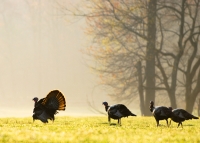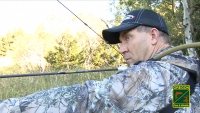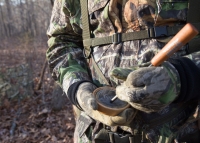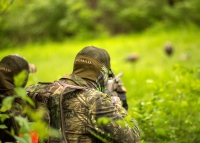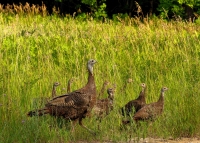
Lifecyle of a wild turkey
Lifecycle of a wild turkey
For hunters, spring marks the beginning of the “turkey year” so let’s trace turkey activity through the year beginning in the spring.
Spring nesting season
The peak of the breeding season has already passed by the time the spring turkey hunting season opens April 15. Toms will breed with multiple hens throughout the spring and early summer. As the eggs develop, the hen will build a ground nest in a place with good cover and close to good brood habitat, which is normally an opening in the forest cover.
Once she starts laying eggs, a hen will lay one egg every 24 to 32 hours – taking about two weeks to lay a full clutch of nine to 13 eggs. In between laying eggs, the hen will focus on feeding and bulking up to withstand the upcoming incubation period.
Once all the eggs have been laid, the hen will incubate them, day and night, for about 28 days. Incubation is interrupted only for an occasional mid-day snack of protein-rich insects.
Turkeys’ first days
Newly hatched chicks – called poults – can walk shortly after hatching and usually leave the nest within 12 - 24 hours. After eight to 14 days, young poults can fly short distances and start roosting in trees.
If a hen loses a clutch shortly after laying, she can re-nest without having to re-breed because the sperm from initial mating remains viable for up to 30 days. Hunters seeing a newly hatched brood of turkeys in late August or September, might think this a hen’s second or third clutch. In fact, it’s more likely the hen has lost a brood and simply re-nested.
The biggest threat to a young turkey’s survival is within its first 10 days of life. If their down gets wet from rain, hypothermia is likely. They also are most vulnerable to predation by ravens, crows, hawks, skunks, raccoon, fox, coyote, bobcats and even stray cats.
Winter flocks and migration
As summer progresses, hens and their growing poults will join other hens and poults. At the same time, mature toms form bachelor flocks, often of like ages. By winter, turkey flocks may grow to 200 or more birds.
As winter weather sets in, turkeys in low elevation habitats, such as valley floors, don’t need to migrate because the winter weather at these elevations is rather mild. However, at higher elevations where severe weather can put birds at risk, turkeys will migrate between lower and higher elevations as weather changes in the spring and fall. This is especially true in parts of central and eastern Oregon.
The number one killer of adult turkeys is prolonged winter storms, where crusted ice keeps them from finding food. But turkeys are tough, and can stay in a tree for several days, losing a good bit of body fat but still surviving.
Under ideal conditions toms can live up to five years (but more likely two or three), hens six to eight years. An eight-year-old hen is rare, however, and comparable to a 100-year-old person.
As winter turns to spring
As winter starts to break up so, too, do the turkey flocks. Hens start moving back to the breeding grounds and bachelor flocks of toms start splitting up. Mature toms return to their strutting grounds, while young males (jakes) look to establish their own breeding territory.
Most old toms are home bodies and don’t travel far, staying within a one-mile range to find hens. Hens, on the other hand, will travel a long way to find a tom or a secluded nesting site. The older the tom, the closer to home he'll stay during the breeding season. This may explain why hens search out toms during the breeding season, and not the other way around.
Hens, on the other hand, may travel miles from their breeding site to find a secluded nesting site, but then may return to their breeding site to raise their poults. Some hens will travel back to the same breeding, nesting and brooding sites year after year. Once a hen finds a perfect nesting location, she may use it for life, as long as conditions don’t change.
Technically, jakes (immature male turkeys) can breed at age one. One the ground, however, they find it difficult to complete with mature toms. This can inspire jakes to travel a long way looking to mate.
It’s the willingness of hens and jakes to travel that has led to the explosion of turkey populations in Oregon. Knowing this, biologists try to transplant birds between existing established flocks, so travelling hens and jakes can fill in the gaps.

